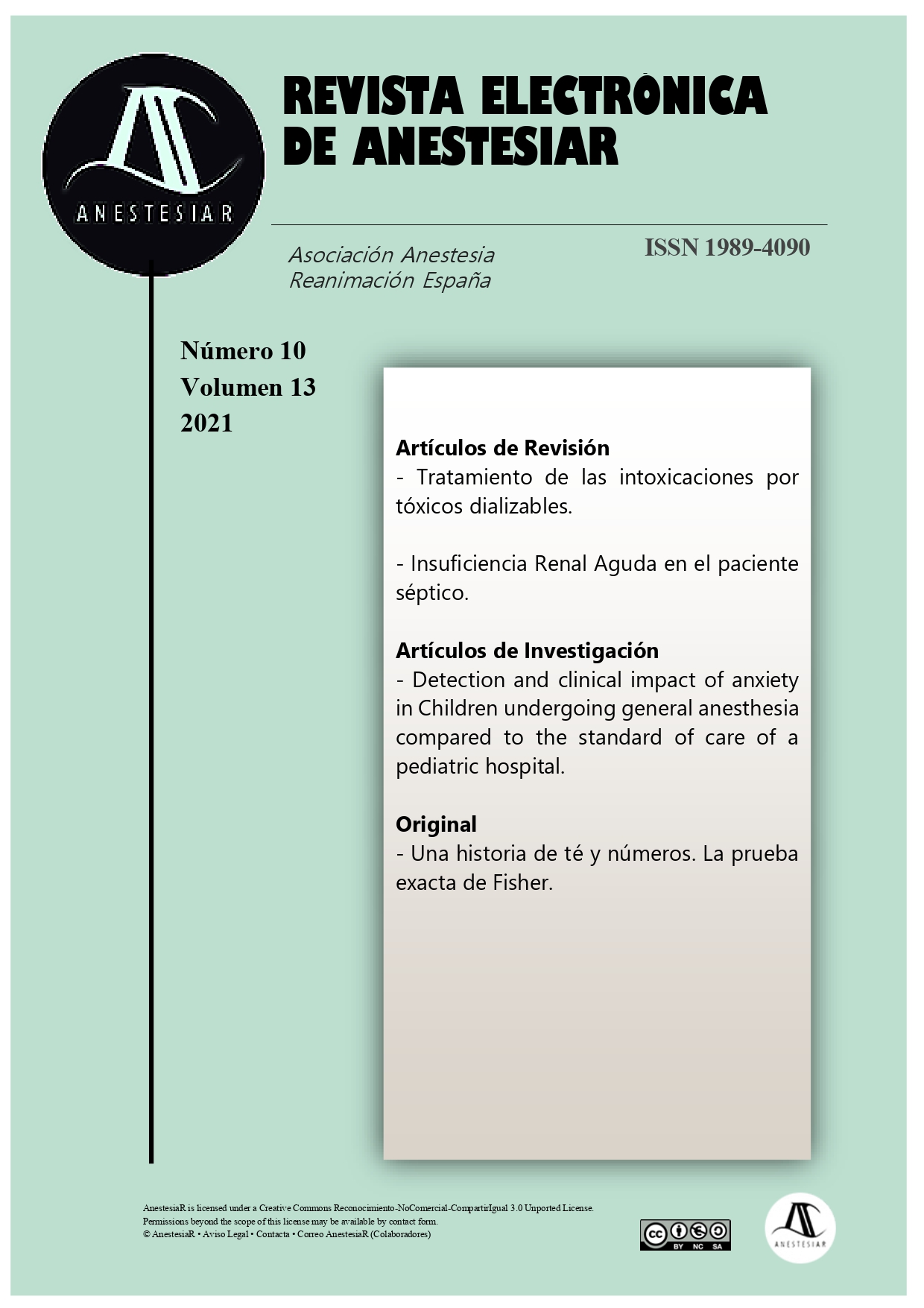Acute Renal Inyuri in the septic patient. Part II. Prevention and treatment strategies.
DOI:
https://doi.org/10.30445/rear.v13i10.984Keywords:
sepsis, septic shock, acute renal injury, critical ill patientAbstract
Among the organic dysfunctions frequently developed in the context of sepsis, the renal system is involved. The limitations in establishing a pathophysiological model of renal failure (ARF) have delayed the development of successful pharmacological interventions, and today much of the treatment of ARF in sepsis is supportive of renal function. The purpose of this review is to provide an updated summary of the proposed ARF prevention strategies and its treatment in patients with sepsis or septic shock. A bibliographic search was carried out using the PubMed database using the MeSH terminology using the following strategy: [(acute kidney injury) AND (sepsis)], [(pathophysiology) AND (sepsis)], (acute kidney injury) AND (prevention)]. Articles with a publication date between 2015 and 2020 categorized as narrative review and clinical practice guidelines were reviewed. Articles with a language other than English or Spanish were excluded.
References
Kellum JA, Chawla LS, Keener C, Singbartl K, Palevsky PM, Pike FL, et al. The Effects of Alternative Resuscitation Strategies on Acute Kidney Injury in Patients with Septic Shock. Am J Respir Crit Care Med. 2016;193(3):281-7. doi: 10.1164/rccm.201505-0995OC. PMID: 26398704; PMCID: PMC4803059.
Rhodes A, Evans LE, Alhazzani W, Levy MM, Antonelli M, Ferrer R, et al. Surviving Sepsis Campaign: International Guidelines for Management of Sepsis and Septic Shock: 2016. Intensive Care Med. 2017;43(3):304-377. doi: 10.1007/s00134-017-4683-6. PMID: 28101605.
Rivers E, Nguyen B, Havstad S, Ressler J, Muzzin A, Knoblich B, et al. Early goal-directed therapy in the treatment of severe sepsis and septic shock. N Engl J Med. 2001;345(19):1368-77. doi: 10.1056/NEJMoa010307. PMID: 11794169.
-Mouncey PR, Osborn TM, Power GS, Harrison DA, Sadique MZ, Grieve RD, et al. ProMISe Trial Investigators. Trial of early, goal-directed resuscitation for septic shock. N Engl J Med. 2015;372(14):1301-11. doi: 10.1056/NEJMoa1500896. PMID: 25776532.
- ARISE Investigators; ANZICS Clinical Trials Group, Peake SL, Delaney A, Bailey M, Bellomo R, Cameron PA, et al. Goal-directed resuscitation for patients with early septic shock. N Engl J Med. 2014;371(16):1496-506. doi: 10.1056/NEJMoa1404380. PMID: 25272316.
- ProCESS Investigators; Yealy DM, Kellum JA, Huang DT, Barnato AE, Weissfeld LA , Pike F et al. A randomized trial of protocol-based care for early septic shock. N Engl J Med. 2014;370(18):1683-93. doi: 10.1056/NEJMoa1401602. PMID: 24635773; PMCID: PMC4101700.
- Raghunathan K, Bonavia A, Nathanson BH, Beadles CA, Shaw AD, Brookhart MA, et al. Association between Initial Fluid Choice and Subsequent In-hospital Mortality during the Resuscitation of Adults with Septic Shock. Anesthesiology. 2015;123(6):1385-93. doi: 10.1097/ALN.0000000000000861. PMID: 26414499.
- Young P, Bailey M, Beasley R, Henderson S, Mackle D, McArthur C, et al. Effect of a Buffered Crystalloid Solution vs Saline on Acute Kidney Injury Among Patients in the Intensive Care Unit: The SPLIT Randomized Clinical Trial. JAMA. 2015;314(16):1701-10. doi: 10.1001/jama.2015.12334. PMID: 26444692.
- Semler MW, Self WH, Wanderer JP, Ehrenfeld JM, Wang L, Byrne DW, et al. SMART Investigators and the Pragmatic Critical Care Research Group. Balanced Crystalloids versus Saline in Critically Ill Adults. N Engl J Med. 2018;378(9):829-839. doi: 10.1056/NEJMoa1711584. PMID: 29485925; PMCID: PMC5846085.
- Zarychanski R, Abou-Setta AM, Turgeon AF, Houston BL, McIntyre L, Marshall JC, et al. Association of hydroxyethyl starch administration with mortality and acute kidney injury in critically ill patients requiring volume resuscitation: a systematic review and meta-analysis. JAMA. 2013;309(7):678-88. doi: 10.1001/jama.2013.430. PMID: 23423413.
- Udeh CI, You J, Wanek MR, Dalton J, Udeh BL, Demirjian S, et al. Acute kidney injury in postoperative shock: is hyperoncotic albumin administration an unrecognized resuscitation risk factor? Perioper Med (Lond). 2018;7:29. doi: 10.1186/s13741-018-0110-y. PMID: 30564306; PMCID: PMC6293561.
- Myburgh JA, Higgins A, Jovanovska A, Lipman J, Ramakrishnan N, Santamaria J. CAT Study investigators. A comparison of epinephrine and norepinephrine in critically ill patients. Intensive Care Med 2008;34:2226- 34. doi: 10.1007/s00134-008-1219-0. PMID:18654759.
- Russell JA, Walley KR, Singer J, Gordon AC, Hébert PC, Cooper DJ, et al. VASST Investigators. Vasopressin versus norepinephrine infusion in patients with septic shock. N Engl J Med. 2008;358(9):877-87. doi: 10.1056/NEJMoa067373. PMID: 18305265.
- De Backer D, Aldecoa C, Njimi H, Vincent JL. Dopamine versus norepinephrine in the treatment of septic shock: a meta-analysis*. Crit Care Med. 2012;40(3):725-30. doi: 10.1097/CCM.0b013e31823778ee. PMID: 22036860.
- Gaudry S, Hajage D, Schortgen F, Martin-Lefevre L, Pons B, Boulet E, et al. AKIKI Study Group. Initiation Strategies for Renal-Replacement Therapy in the Intensive Care Unit. N Engl J Med. 2016;375(2):122-33. doi: 10.1056/NEJMoa1603017. PMID: 27181456.
- Zarbock A, Kellum JA, Schmidt C, Van Aken H, Wempe C, Pavenstädt H, et al. Effect of Early vs Delayed Initiation of Renal Replacement Therapy on Mortality in Critically Ill Patients With Acute Kidney Injury: The ELAIN Randomized Clinical Trial. JAMA. 2016;315(20):2190-9. doi: 10.1001/jama.2016.5828. PMID: 27209269.
- Mehta RL, Pascual MT, Soroko S, Chertow GM. PICARD Study Group. Diuretics, mortality, and nonrecovery of renal function in acute renal failure. JAMA 2002;288:2547-53. doi: 10.1001/jama.288.20.2547. PMID:12444861.
- Spapen H. N-acetylcysteine in clinical sepsis: a difficult marriage. Crit Care. 2004;8(4):229-30. doi: 10.1186/cc2887. PMID: 15312203; PMCID: PMC522849.
- Peters E, Heuberger JAAC, Tiessen R, van Elsas A, Masereeuw R, Arend J, et al. Pharmacokinetic Modeling and Dose Selection in a Randomized, Double-Blind, Placebo-Controlled Trial of a Human Recombinant Alkaline Phosphatase in Healthy Volunteers. Clin Pharmacokinet. 2016;55(10):1227-1237. doi: 10.1007 s40262-016-0399-y. PMID: 27147514; PMCID: PMC5021756.
- Fujii T, Luethi N, Young PJ, Frei DR, Eastwood GM, French CJ, et al. VITAMINS Trial Investigators. Effect of Vitamin C, Hydrocortisone, and Thiamine vs Hydrocortisone Alone on Time Alive and Free of Vasopressor Support Among Patients With Septic Shock: The VITAMINS Randomized Clinical Trial. JAMA. 2020;323(5):423-431. doi:10.1001/jama.2019.22176. PMID: 31950979; PMCID: PMC7029761.
Published
How to Cite
Issue
Section
License
Copyright (c) 2021 Revista Electrónica AnestesiaR

This work is licensed under a Creative Commons Attribution-ShareAlike 4.0 International License.
 Envío y derechos de autor
Envío y derechos de autor


 Revista Electrónica AnestesiaR by
Revista Electrónica AnestesiaR by 